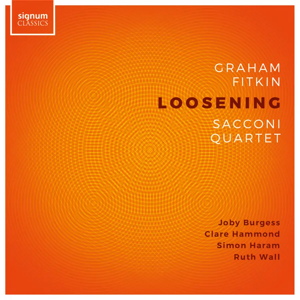
Graham Fitkin (b. 1963)
Loosening
Loosening (2021)
Slow (1990)
Distil (2014)
Touch (2005)
Recur (2016)
Simon Haram (soprano saxophone), Graham Fitkin, Ruth Wall (organ), Joby Burgess (percussion), Clare Hammond (piano), Ruth Wall (harp), Sacconi Quartet
rec. 2023, Folkestone and Sevenoaks, UK
Signum Classics SIGCD792 [2 CDs: 102]
Graham Fitkin is a British musician who over the last forty years has built up an enviable reputation as composer, pianist and conductor. His compositions are broadly minimalist though one or two are maximalist. Born in Cornwall in 1963, he studied at Nottingham University with Peter Nelson and Nigel Osborne and then in The Netherlands with Louis Andriessen at Koninklijk Conservatorium in The Hague. The Dutch man’s aesthetic can be heard as a major influence. He has written many works for solo and multiple pianos, as well as for music for dance, where his dynamic sound world has been much appreciated. There are also larger works including a Cello Concerto written for Yo Yo Ma which was premiered at the BBC Proms in 2011.
Fitkin is clearly drawn to the string quartet genre and wrote six between 1992 and 2006. All have been recorded for Signum Classics by the Sacconi Quartet (SIGCD518). In all of them he managed to find a different sound world and compositional approach. So too in the works recorded here, string quartets plus one, the worlds created are very varied. In them he questions the nature of the connections between quartet and visitors.
Disc one consists of two twenty-five-minute works. In the first Loosening the strings are joined by a soprano saxophone. I found it hard to get into, not because of any difficult harmonic writing or rhythmic complexity but that the strings and saxophone follow their own paths, only occasionally joining up before breaking off again. It felt a little like trying to engage with two similar but different conversations going on at the same time. Both were interesting but my brain in focussing in and out of each part and I did not quite get the gist of either.
They know each other is present but they never really engage. The piece is centred around sustained sounds, into which string slides come in and out of focus. The solo saxophone gently continues its solo journey unbothered by the group’s behaviour. Beautifully played and recorded but not for me.
There are two additions in Slow in the shape of two organs played by the composer and his partner Ruth Hall who is also the solo harpist in Recur. At first their role is distinct from that of the quartet, often playing on their own. But in the end the quartet have coaxed the organs into a sort of partnership. There is much use made of the sustaining ability of the organs to which the quartet add more questioning rhythmic material. That said there are some beautiful long, lyrical melodies which sing above the chordal textures. There is an almost symphonic feel to the structuring of these twenty-five minutes, with a satisfying inevitability to the final sustained chords. I realise I have never heard this combination before and what a fascinating sound world it is.
Disc two has three shorter works all of which are much peppier. In Distil the soloist is a percussionist. Here the composer initially and intriguingly writes against type with the percussionist playing gongs and bells, vibraphone, crotales and glockenspiel, playing on their sustaining ability while the strings play short sounds, pizzicato or col legno. As the piece develops the protagonists shift their sound worlds, until crossing over. The strings introduce longer sustained notes while the percussionist takes over the staccato sounds. My ears were constantly surprised by the kaleidoscope of sounds and were rather disappointed when it finished.
With Touch we are in the more traditional sound world of the piano quintet. But there is nothing dull or traditional about it. From the off the pianist and strings maintain a constant lively dialogue. They imitate one another, coaxing each other along, while retaining their individuality. It sounds fearsomely difficult to get together the brilliant piano part having an improvisatory feel to it. It gets a bit funky in places maybe Igor Stravinsky meeting up with Chick Chorea’s Senor Mouse. It is enormously engaging and a really outstanding addition to the genre.
The programme ends with Recur in which the strings are joined by solo harp. What a rollercoaster of a work this is! There is much incident, much movement, much variety and much excitement. If this was a journey it is one I want to make. To start the strings make use of all their plucking capabilities, setting up a textural variety to the harp which although plucking of course has a more mellow, laid-back approach to the same material. Like a Californian having a conversation with some New Englanders. As the movement moves on so does the conversation between the two, each borrowing arguments from the other. The harp shows it is no push over and in the end seems to be leading in the discussions which ultimately ends amicably. The composer shows a real understanding of the capabilities of the harp. There are some marvellous dense chords on the harp echoed in the strings and vice versa highlighting great textural diversity. I hope someone will commission a full-scale harp concerto from Fitkin, that would surely be something.
Fitkin and the Sacconi Quartet have worked together for many years, and they create his sound world perfectly. They make their various guests welcome and there is a lively interchange which is beautifully captured by the Signum engineers.
Paul RW Jackson
Buying this recording via a link below generates revenue for MWI, which helps the site remain free.




















